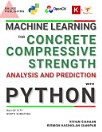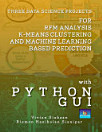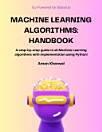DATA SCIENCE FOR SALES ANALYSIS, FORECASTING, CLUSTERING, AND PREDICTION WITH PYTHON
About this ebook
We began by meticulously exploring the dataset, examining its structure, and identifying any missing or inconsistent data. By visualizing features' distributions and conducting statistical analyses, we gained a better understanding of the data's characteristics and potential challenges.
The first key aspect of the project was weekly sales forecasting. We employed various machine learning regression models, including Linear Regression, Support Vector Regression, Random Forest Regression, Decision Tree Regression, Gradient Boosting Regression, Extreme Gradient Boosting Regression, Light Gradient Boosting Regression, KNN Regression, Catboost Regression, Naïve Bayes Regression, and Multi-Layer Perceptron Regression. These models enabled us to predict weekly sales based on relevant features, allowing us to uncover patterns and relationships between different factors and sales performance. To optimize the performance of our regression models, we employed grid search with cross-validation. This technique systematically explored hyperparameter combinations to find the optimal configuration, maximizing the models' accuracy and predictive capabilities.
Moving on to data segmentation, we adopted the widely-used K-means clustering technique, an unsupervised learning method. The goal was to divide data into distinct segments. By determining the optimal number of clusters through grid search with cross-validation, we ensured that the clustering accurately captured the underlying patterns in the data.
The next phase of the project focused on predicting the cluster of new customers using machine learning classifiers. We employed powerful classifiers such as Logistic Regression, K-Nearest Neighbors, Support Vector, Decision Trees, Random Forests, Gradient Boosting, Adaboost, Extreme Gradient Boosting, Light Gradient Boosting, and Multi-Layer Perceptron (MLP) to make accurate predictions. Grid search with cross-validation was again applied to fine-tune the classifiers' hyperparameters, enhancing their performance.
Throughout the project, we emphasized the significance of feature scaling techniques, such as Min-Max scaling and Standardization. These preprocessing steps played a crucial role in ensuring that all features were on the same scale, contributing equally during model training, and improving the models' interpretability.
Evaluation of our models was conducted using various metrics. For regression tasks, we utilized mean squared error, while classification tasks employed accuracy, precision, recall, and F1-score. The use of cross-validation helped validate the models' robustness, providing comprehensive assessments of their effectiveness.
Visualization played a vital role in presenting our findings effectively. Utilizing libraries such as Matplotlib and Seaborn, we created informative visualizations that facilitated the communication of complex insights to stakeholders and decision-makers.
Throughout the project, we followed an iterative approach, refining our strategies through data preprocessing, model training, and hyperparameter tuning. The grid search technique proved to be an invaluable tool in identifying the best parameter combinations, resulting in more accurate predictions and meaningful customer segmentation.
In conclusion, this data science project demonstrated the power of machine learning techniques in sales analysis, forecasting, and customer segmentation. The insights and recommendations generated from the models can provide valuable guidance for businesses seeking to optimize sales strategies, target marketing efforts, and make data-driven decisions to achieve growth and success. The project showcases the importance of leveraging advanced analytical methods to unlock hidden patterns and unleash the full potential of data for business success.
Ratings and reviews
About the author
Vivian Siahaan is a fast-learner who likes to do new things. She was born, raised in Hinalang Bagasan, Balige, on the banks of Lake Toba, and completed high school education from SMAN 1 Balige. She started herself learning Java, Android, JavaScript, CSS, C ++, Python, R, Visual Basic, Visual C #, MATLAB, Mathematica, PHP, JSP, MySQL, SQL Server, Oracle, Access, and other programming languages. She studied programming from scratch, starting with the most basic syntax and logic, by building several simple and applicable GUI applications. Animation and games are fields of programming that are interests that she always wants to develop. Besides studying mathematical logic and programming, the author also has the pleasure of reading novels. Vivian Siahaan has written dozens of ebooks that have been published on Sparta Publisher: Data Structure with Java; Java Programming: Cookbook; C ++ Programming: Cookbook; C Programming For High Schools / Vocational Schools and Students; Java Programming for SMA / SMK; Java Tutorial: GUI, Graphics and Animation; Visual Basic Programming: From A to Z; Java Programming for Animation and Games; C # Programming for SMA / SMK and Students; MATLAB For Students and Researchers; Graphics in JavaScript: Quick Learning Series; JavaScript Image Processing Methods: From A to Z; Java GUI Case Study: AWT & Swing; Basic CSS and JavaScript; PHP / MySQL Programming: Cookbook; Visual Basic: Cookbook; C ++ Programming for High Schools / Vocational Schools and Students; Concepts and Practices of C ++; PHP / MySQL For Students; C # Programming: From A to Z; Visual Basic for SMA / SMK and Students; C # .NET and SQL Server for High School / Vocational School and Students. At the ANDI Yogyakarta publisher, Vivian Siahaan also wrote a number of books including: Python Programming Theory and Practice; Python GUI Programming; Python GUI and Database; Build From Zero School Database Management System In Python / MySQL; Database Management System in Python / MySQL; Python / MySQL For Management Systems of Criminal Track Record Database; Java / MySQL For Management Systems of Criminal Track Records Database; Database and Cryptography Using Java / MySQL; Build From Zero School Database Management System With Java / MySQL.
Rismon Hasiholan Sianipar was born in Pematang Siantar, in 1994. After graduating from SMAN 3 Pematang Siantar 3, the writer traveled to the city of Jogjakarta. In 1998 and 2001 the author completed his Bachelor of Engineering (S.T) and Master of Engineering (M.T) education in the Electrical Engineering of Gadjah Mada University, under the guidance of Prof. Dr. Adhi Soesanto and Prof. Dr. Thomas Sri Widodo, focusing on research on non-stationary signals by analyzing their energy using time-frequency maps. Because of its non-stationary nature, the distribution of signal energy becomes very dynamic on a time-frequency map. By mapping the distribution of energy in the time-frequency field using discrete wavelet transformations, one can design non-linear filters so that they can analyze the pattern of the data contained in it. In 2003, the author received a Monbukagakusho scholarship from the Japanese Government. In 2005 and 2008, he completed his Master of Engineering (M.Eng) and Doctor of Engineering (Dr.Eng) education at Yamaguchi University, under the guidance of Prof. Dr. Hidetoshi Miike. Both the master's thesis and his doctoral thesis, R.H. Sianipar combines SR-FHN (Stochastic Resonance Fitzhugh-Nagumo) filter strength with cryptosystem ECC (elliptic curve cryptography) 4096-bit both to suppress noise in digital images and digital video and maintain its authenticity. The results of this study have been documented in international scientific journals and officially patented in Japan. One of the patents was published in Japan with a registration number 2008-009549. He is active in collaborating with several universities and research institutions in Japan, particularly in the fields of cryptography, cryptanalysis and audio / image / video digital forensics. R.H. Sianipar also has experience in conducting code-breaking methods (cryptanalysis) on a number of intelligence data that are the object of research studies in Japan. R.H. Sianipar has a number of Japanese patents, and has written a number of national / international scientific articles, and dozens of national books. R.H. Sianipar has also participated in a number of workshops related to cryptography, cryptanalysis, digital watermarking, and digital forensics. In a number of workshops, R.H. Sianipar helps Prof. Hidetoshi Miike to create applications related to digital image / video processing, steganography, cryptography, watermarking, non-linear screening, intelligent descriptor-based computer vision, and others, which are used as training materials. Field of interest in the study of R.H. Sianipar is multimedia security, signal processing / digital image / video, cryptography, digital communication, digital forensics, and data compression / coding. Until now, R.H. Sianipar continues to develop applications related to analysis of signal, image, and digital video, both for research purposes and for commercial purposes based on the Python programming language, MATLAB, C ++, C, VB.NET, C # .NET, R, and Java.








